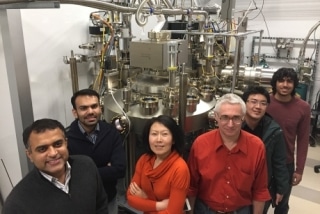Mar 2 2017
 Members of the Xing Research Group-Debdeep Jena, Moudud Islam, Huili (Grace) Xing, Vladimir Protasenko, Kevin Lee and Shyam Bharadwaj-are pictured in front of one of the molecular beam epitaxy systems used in their latest work. Credit: Cornell University
Members of the Xing Research Group-Debdeep Jena, Moudud Islam, Huili (Grace) Xing, Vladimir Protasenko, Kevin Lee and Shyam Bharadwaj-are pictured in front of one of the molecular beam epitaxy systems used in their latest work. Credit: Cornell University
The Ultraviolet C light, or the UV-C, is the darkest form of UV light. It is unique due to its ability to kill harmful organisms.
The UV-C light has a wavelength of 200 to 280 nm, and penetrates the membranes of dust mites, bacteria, mold, and viruses, attacking their DNA and ultimately destroying them. The Faroese-Danish physician Niels Finsen invented the use of UV light as a remedy for tuberculosis, consequently winning the Nobel Prize for Medicine in the year 1903. From then, sanitization using UV-C light has been practiced for over a century.
Much of the deep-UV lamps used at present are inefficient, bulky, and mercury-based - proving hazardous to the environment. A Cornell research team headed by Huili (Grace) Xing and Debdeep Jena worked in collaboration with researchers from the University of Notre Dame and has made an advancement in developing a compact and a more environment-friendly substitute.
The research team has demonstrated the ability of using atomically controlled thin monolayers of aluminum nitride (AlN) and gallium nitride (GaN) to generate deep-UV emission with a light-emitting diode (LED) in the wavelength range of 232 to 270 nm. The 232-nm emission reported by the researchers is the shortest recorded wavelength generated by using GaN as the light-emitting material. A research based in Japan earlier recorded 239 nm.
The study titled “MBE-grown 232 - 270 nm deep-UV LEDs using monolayer thin binary GaN/AlN quantum heterostructures” was published online in the journal Applied Physics Letters on 27 January 2017.
UV-C light is very attractive because it can destroy the DNA of species that cause infectious diseases, which cause contamination of water and air.
SM (Moudud) Islam, Postdoctoral Researcher, Cornell University
The main drawback of ultraviolet LEDs is efficiency, which is calculated from three parts; internal quantum efficiency (IQE) - the proportion of all the electrons in the active region that generate UV light or photons; injection efficiency - the proportion of electrons traveling through the device that are injected into the active region; and light extraction efficiency - the proportion of the produced photons that can be extracted from the device and are found to be really useful.
If you have 50 percent efficiency in all three components ... multiply all of these and you get one-eighth. You’re already down to 12 percent efficiency.
SM (Moudud) Islam, Postdoctoral Researcher, Cornell University
Although all three efficiency factors are found to decline in the deep-UV range, the researchers discovered that both light extraction efficiency and IQE can be improved by using GaN in the place of traditional aluminum GaN.
Using a polarization-induced doping scheme for both the positive (hole) and negative (electron) carrier regions, the injection efficiency increased. This is a method explored by the research them in an earlier research.
After proving their idea of improved deep-UV LED efficiency, the next assignment of the researchers would be to package it into a device that can reach the market some day. Apart from other uses, deep-UV LEDs are employed in the detection of counterfeit currency as well as in the preservation of food.
Further research in this area will concentrate on packaging the new as well as prevalent technologies in identical devices to enable comparison of the technologies.
In terms of quantifying the efficiency, we do want to package it within the next few months and test it as if it was a product, and try to benchmark it against a product with one of the available technologies.
Debdeep Jena, Cornell University
Vladimir Protasenko, research associate; and Kevin Lee and Shyam Bharadwaj, electrical and computer engineering doctoral students, were the other Cornell collaborators.
Grants from the National Science Foundation and the Air Force Office of Scientific Research supported the research.